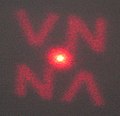Diffractive optical element
Diffractive optical elements (abbreviated DOE ) are optical elements for forming a light beam , often in the form of a laser beam . The physical principle is diffraction (also called diffraction) at an optical grating .
functionality
Diffractive optical elements are glass substrates onto which microstructures are applied by photolithography . The different optical path lengths of the partial beams lead to phase modulations in them , which creates interference patterns. In addition, the amplitude is modulated by constructive and destructive superposition . In this way, the intensity patterns in a laser beam can be manipulated through clever design . DOEs can serve two purposes: they can form a laser beam ( English shaping beam ) or in several partial beams disassemble (engl. Beam splitting ).
The microstructure in the DOE can shape the beam through the refractive index or through height modulation. Good components achieve efficiencies of 80–99% and transmittance of 95–99%.
Applications
Diffractive optical elements are now used in a wide variety of areas, including photo technology , medicine , vehicle technology , multimedia , image processing , light section measurement , and as security technology for document papers . DOEs can now be produced in such high quality that they can be used with high-power lasers for industrial applications. Here they are mainly used for beam shaping and beam splitting.
manufacturing engineering
In manufacturing technology , DOEs are used instead of conventional refractive lenses to modulate the intensity distribution. The normal distribution of the beam intensity of a laser beam over the beam diameter is roughly equal to that of a Gaussian bell curve . This is unfavorable for some manufacturing processes (e.g. laser drilling ), since the intensity at the edge of the beam is insufficient for the formation of plasma , which is necessary for laser drilling through evaporation. Instead, the reduced amount of energy heats the material and leads to melt pools that reduce the quality of the hole. This is why you need as uniform an intensity distribution as possible over the entire beam diameter. Diffractive optical elements can do just that, as they can generate a wide variety of intensity distributions.
DOEs have several advantages over mask beamforming:
- Parts of the beam with insufficient intensity are not simply masked out, but the intensity of the beam is evenly distributed by the DOE. As a result, the beam energy can be used almost completely.
- The beam can be focused on diameters at which diffraction phenomena would already occur with a mask, which would reduce the beam quality.
- The overall system can be kept simpler because the DOE can take over the tasks of several conventional optical components.
However, the simpler overall system is also a disadvantage, since the diffractive optical elements used are manufactured for a more specific purpose than conventional optics. This makes them more expensive and not as flexible to use as conventional components.
Hyalic windows
A hyalic window is the transparent field on a plastic banknote . The windows which are provided for the diffractive optical element have an optically milky film. This visible film is a microstructure that can only be deciphered with a laser. Raised numbers, letters or trademarks can also appear in the hyalic window, but they have no DOE functions.
Using this technology, it is possible to incorporate logos , the denomination of a bank note , trademarks, etc. into a carrier film. What was known as a watermark on paper is projected onto a surface here using a laser beam. The production of a diffractive optical element is just as complex as a watermark and has so far been viewed as very forgery-proof.
The DOE image can be made visible with simple aids: a standard laser pointer is used to project a laser beam onto a flat white wall. The plastic banknote is held in the laser beam so that the beam falls through the milky hyaline window. By gently moving it back and forth, a clear image should be visible on the wall.
- Vietnam
This technology has been used as a security feature on plastic banknotes for some time . Banknotes from the following countries already have this security feature:
-
Brunei : The banknotes were issued on the occasion of the 58th birthday of his Majesty Sultan Sir Muda Hassanal Bolkiah . HB50 or HB100 can be seen as DOE; the HB stands for Hassanal Bolkiah.
- 50 Brunei dollars dated July 15, 2004
- 100 Brunei dollars dated July 15, 2005
-
Vietnam : Ornaments or VN, which stands for Việt Nam, can be seen as DOE.
- 50,000 Đồng as of December 17, 2003
- 100,000 Đồng as of September 1, 2004
- 500,000 Đồng as of December 17, 2003
-
Papua New Guinea
- 100 Kina dated November 21, 2005
Computer generated holograms
Computer-generated holograms are increasingly used in technology to fulfill various tasks: mapping of alignment structures, production of non-linear lenses, shaping of beam distributions (beam shaper), logo representation in laser technology.
photography
Diffractive optical elements are used in individual lenses (Nikon PF lenses and Canon DO lenses with “multiple diffraction members ”) for single -lens reflex cameras . The aim is to minimize chromatic aberrations while at the same time making the lenses more compact and lighter.
See also
Web links
- Diffractive optical elements in industrial applications - Technical article on DOEs - design of the elements, manufacturing processes, areas of application (PDF file; 306 kB)
- Hybrid diffractive refractive lenses (PDF file; 296 kB)


